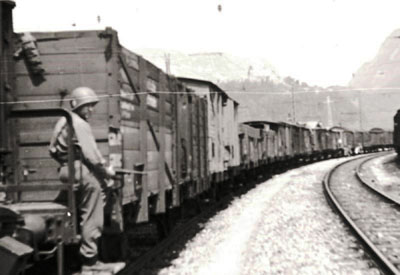Smelted Away
The story of a train, laden with the wealth of murdered Jews, that disappeared into the night
Tibor Krausz
The Jerusalem Report, April 7, 2003
When I was a boy in goulash communist Hungary in the early 1980s, my grandmother would often regale me with stories about our decimated family’s prewar riches. She would tell me how, less than two years after my grandfather’s death in the winter of 1942 while digging anti-tank trenches on the Russian front, thugs bearing the Hungarian fascist Arrow Cross Party’s insignia arrived one day and stripped her home of all movable valuables: The daylight robbers even took the gold-plated medals my grandfather had won as a champion wrestler. I never cared too much about bygone family fortunes. But boy, would I have loved to see those medals.
Gabriel Schellinger shared similar sentiments. The elderly Holocaust survivor, who lived through the war as a teenager in Budapest, would pore over old documents in a Jerusalem archive, seeking not restitution for family possessions lost in the compulsory expropriations of 1944, but simply answers to what had happened to his parents’ gold wedding band. Coincidentally, Ronald W. Zweig, a professor of modern Jewish history at Tel Aviv University, was conducting a historical quest of his own in the same archives on the broader implications of the very question. His findings about “a last unsolved mystery of the war” dedicated to the late Schellinger, are neatly laid out in “The Gold Train.”

During the night of March 29 and 30, 1945, a locomotive, accompanied by an auxiliary convoy of trucks, dragged 46 nondescript freight cars across the Hungarian border into Austria. The ramshackle procession was manned by fleeing minions of the deposed pro-Nazi Arrow Cross government; it was laden with gold jewelry, silverware, religious paraphernalia, exquisite furniture and Persian carpets, all seized during 1944 from the assimilated and well-heeled Jews of Hungary, who had until 1938 enjoyed full civil liberties and formed the backbone of the country’s cultural and financial elite. The loot and its keepers were on their way to the “Alpine Redoubt,” a fortified eyrie high up in the German Alps, where loyal leaders of the Nazi Eagle (the remnants of Hitler’s regime) and their steadfast Hungarian followers would get holed up and await their chance for a Second Coming: another shot at world domination as the Soviet Union and the West would inevitably fall on each other.
An absurd idea, yes — especially as no such redoubt was in the offing. So after a bumpy ride, the cache, minus some pilfered items, ended up in Salzburg and Allied hands. Guess what: the loot’s journey was just beginning. The liberating U.S. forces duly considered the train’s prized contents “persecutee property,” shorthand for looted Jewish assets, and rebuffing the Hungarian state’s appeals for their return, earmarked them for the repatriation of displaced Jewish refugees. But not so fast. The valuables, whose worth was estimated at up to $300 million ($3 billion in today’s currency) by contemporary Jewish organizations, careened from one ownership claim to another, buffeted between the conflicting interests of erstwhile allies in a redrawn world of postwar settlements. Meanwhile, as wrangling over restitution played out in London, Paris, New York and Budapest, the loot’s value was fast depleting not only because wishful thinking probably had greatly inflated it in the first place, but also because various handlers were busy filching loose items. Finally, throughout the late 1940’s, marketable personal accessories ended up as bargains at auctions in New York; crates of diamonds vanished without a trace; the Soviet Union skimmed off its share, too.
The final twist to the Gold Train saga comes with Zweig’s pithy conclusion: The prewar wealth of Hungary’s affluent Jewry lay not so much in its amount of cartable gold, as the avaricious despoilers reckoned, but in the far more intangible prosperity of its cumulative cultural and financial influence. “It was the people who gave real value to the items on the Gold Train; the value was not inherent in the objects themselves,” Zweig writes. In other words, it’s the great difference in value between a stamp collection’s worth to a thief and to its owner. And hence the incalculable loss: tons of irreplaceable religious and personal items smelted into gold and silver ingots.
The few blemishes on Zweig’s meticulously researched opus are small, if conspicuous, inaccuracies; such as when he identifies a Czech-Hungarian eyewitness from a labor battalion forced to bury some of the Gold Train’s treasure as “probably Jewish,” while the man’s name (Károly Oláh) suggests that he was almost certainly a Gypsy. That said, Zweig provides a lucid and engaging account of the shifting alliances of the postwar years and the Allies’ intensifying bickering over the spoils of war. He also steers clear of speechifying in the service of restitution lawsuits underway in New York, and allows the facts, more damning than any jeremiad, to speak for themselves.
As for the Gold Train’s destination? If the past is any guide, the locomotive will be chugging ahead, dragging heavy wagonloads of gold, precious stones, priceless family mementos, and not least, despoiled victims’ receding hopes for compensation. Somewhere there, disappearing over the horizon in a haze from the steam engine, are the wedding ring of Gabriel Schellinger’s parents and my grandfather’s gold medals. But now at least we have a minutely detailed map for the route of the train carrying them. And that’s compensation of sorts in itself.